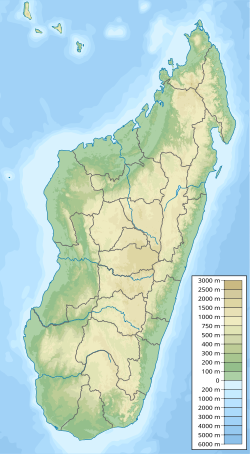热门问题
时间线
聊天
视角
安卡拉納保護區
马达加斯加北部的自然保护区 来自维基百科,自由的百科全书
Remove ads
安卡拉納保護區(法語:Réserve spéciale d'Ankarana)是馬達加斯加迪亞納大區的一個保護區,成立於1956年。保護區境內有由中侏羅紀時期的石灰岩所組成、由部分植被覆蓋的高原。 [1]該保護區年平均降雨量約2,000公厘[1],保護區內部分岩石被侵蝕而形成洞穴,並形成伏流,這是一種喀斯特地形,崎嶇的地形與茂密的植被阻礙人類進入該地區。
保護區南部的入口位於馬哈馬西娜(Mahamasina),有6號國道經過。此處位於安齊拉納納西南方約108公里,安比盧貝東北方約29公里。該保護區於2008年列為馬達加斯加世界遺產預備名單,編號5314[2]。

Remove ads
地理
高原的東面緩慢傾斜,但西面突然止於一個從北向南延伸25公里的陡峭懸崖,稱「安卡拉納之牆」(Wall of Ankarana),此牆高達280公尺[3]。在南面,石灰岩塊斷裂成獨立的尖頂,被稱為塔式岩溶(tower karst)。在高原的中心,地震活動和億萬年的降雨將石灰岩溶解在深谷中,有時會重新沉積成流石帶。在鈣化的上層被完全侵蝕的地方,較硬的基岩被蝕成「黥基」(馬達加斯加語:tsingy,意為人類無法涉足之地)的通道和山脊。該地區到處都是玄武岩巨石,玄武岩也滲入山塊深處的峽谷中[3]。
探索
1960年代起,旅居國外的法國人讓·杜弗洛斯(Jean Duflos,在當地結婚後改名為讓·拉多菲勞,Jean Radofilao)與洞穴學家一起對山塊的洞穴系統和地下河進行探索[4][5][6]。他們繪製了山塊內約100公里的洞穴通道[7]。安德拉菲貝洞穴是最容易進入的洞穴之一,僅該洞穴就包括至少8.035公里的水平通道。該山丘有馬達加斯加最長的洞穴系統,也是非洲最大的地下洞穴網路[8]。
動物

安卡拉納保護區探險隊1980年代起對保護區的動植物進行編目[9],此記載於珍·威爾遜-霍華斯博士的遊記《失落的世界之狐猴》[10]以及多個科學出版物中[11][12][13][14]。保護區發現已滅絕大型狐猴的亞化石遺骸[15][16][17][18],以及仍存在但尚未有記載的盲魚[19][20]、蝦[21],以及其他無脊椎動物物種[22][23]。幾位探險隊成員提供照片給一本馬達加斯加圖說指南,該指南以安卡拉納的鱷魚洞為特色點[24]。
在1986年考察期間,菲爾·查普曼(Phil Chapman)和讓-埃利·蘭德里亞馬西(Jean-Elie Randriamasy)整理了一份保護區鳥類名單,記錄32個科的65種鳥類,占馬達加斯加所有鳥類近三分之一,他們還注意到一種有趣的行為。他們報告指出,許多以昆蟲為食的小鳴禽使用一種不同尋常的策略:包括馬達加斯加壽帶鳥、北雜鶥、短嘴旋木鵯、馬島旋木鵯、馬島黑鵯、斯韋花蜜鳥、白額厚嘴鵙等物種在一起覓食,不同的鳥類似乎都專注於牠們特定的區域覓食昆蟲獵物,一些集中於樹幹與大分枝、一些集中於小樹枝、一些集中於樹葉下方。通過這樣的方式共同行動,牠們可能會提高覓食效率,因為各種鳥類都可以捕捉到目標獵物,也更安全地免受掠食者的攻擊,因為一大群鳥類分頭警戒,更有可能發現接近中的危險處。[13]
安卡拉納保護區是冠狐猴、桑氏美狐猴,和其他哺乳動物種的重要棲息地。其他發現的物種包括北鼬狐猴、赤褐倭狐猴、肥尾鼠狐猴、叉斑鼠狐猴、東部毛狐猴、冕狐猴、佩氏冕狐猴、指猴、灰馴狐猴。[13]
參見
- 馬達加斯加旱生闊葉林
- 冠狐猴
參考文獻
外部連結
Wikiwand - on
Seamless Wikipedia browsing. On steroids.
Remove ads


